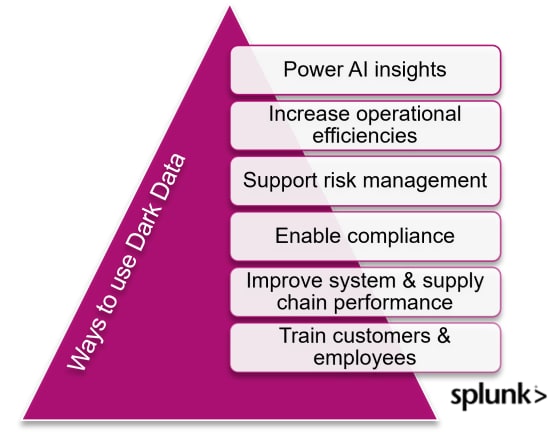 By Tyler York August 03, 2023
By Tyler York August 03, 2023
Dark data is all of the unused, unknown and untapped data across an organization. This data is generated as a result of users’ daily interactions online with countless devices and systems — everything from machine data to server log files to unstructured data derived from social media.
Organizations may consider this data too old to provide value, incomplete or redundant, or limited by a format that can’t be accessed with available tools. All too often, they don’t even know it exists.
However, dark data may be one of an organization’s biggest untapped resources. Data is increasingly a major organizational asset and competitive organizations will need to tap into its full value. Further, more stringent data regulations may necessitate complete management of an organization’s data.
Before it was officially known as “dark data,” consulting firm Deloitte alluded to impending data challenges with a report on how organizations can find opportunities within unstructured data, providing critical foresight into industry-wide struggles around unknown data. As big data continues to grow exponentially, so too does the amount of hidden dark data.
All that data has to be good for something — right?
In this article, we’ll explore dark data and how it can affect your organization, how organizations can research, access and analyze their dark data, and how they can create a comprehensive strategy to prepare for a new data future.
Why you should care about dark data
Organizations have access to more data than ever before. As we’ve migrated collectively into the data age, a few things have become incredibly clear:
- Data is key to future business success: Organizations expect value out of their data. Most organizations measure key performance indicators or use data to inform decision-making in some capacity.
- Enterprises are leaving swathes of data untouched: Despite the growing importance of data, more and more data goes underutilized or flat-out undiscovered.
Whether organizations lack the necessary resources, tools and skills to make the abundance of data actionable, or they simply haven’t discovered the data they’re generating, that data is critical in decision-making.
We probably wouldn’t feel too comfortable making a decision based on 40% of the available information — so why would we do that at the enterprise level?
Let’s talk about some ways we can fill the gap.
How to discover dark data
Because dark data is, by definition, data we don’t know about, we need to do some digging to get started. Organizations can assess their dark data in several ways:
- Hire independent consultants
- Catalog data sources and use data profiling tools
- Use data sampling to analyze large data sets
- Audit IAM settings to understand how much data is inaccessible through security measures
- Monitor data usage and consumption across departments, identifying underutilized resources
- Use natural language processing or text mining to analyze unstructured data
- Interview stakeholders on current and potential data usage
- Implement automated data discovery tools
Analyzing your dark data will enable a wider swath of less technical employees to understand your organization’s needs. Specifically, a dark data analytics solution can provide a more comprehensive, insightful and accurate understanding of users’ data and give them a big picture of their environment.

Making use of dark data
While all that data’s been collecting dust, odds are your organization has been missing out on some major insights. Dark data can help organizations to:
- Determine which department in the organization owns what data
- Improve quality assurance processes
- Detect and correct process errors
- Look for privacy loopholes
- Identify security vulnerabilities
The number of specific use cases is vast, but let’s zero in on just a few:
Power artificial intelligence insights
One very important use for dark data is its role in fueling AI-powered solutions — more data increases the wealth of information that AI can analyze and should allow AI tools to produce deeper and more accurate insights.
(Learn about generative AI, adaptive AI & what these mean for cybersecurity.)
Improve operational efficiency
Shining a light on dark data might highlight opportunities for operational improvement, for example:
- Log analysis can point to system bottlenecks or performance issues
- Resource allocation patterns may reveal opportunities for optimization
- System monitoring dark data may allow for predictive maintenance
Assist compliance and risk management
Dark data may contain information relevant to compliance requirements or risk management. Analyzing this data can help identify potential compliance issues or assess risks associated with certain business practices.
That previously untouched discovered data can help:
- Enhance risk modeling accuracy
- Provide essential information needed for regulatory reporting
- Identify third-party risks
- Assist in creating early warning systems
- Provide evidence and context for audits or investigations
Harness the many benefits of dark data
The list of potential examples here is pretty extensive and can get incredibly specific. Whether it’s a chance to improve internal system performance, customer support interactions, supply chain processes or internal training, dark data can reveal a vast array of opportunity for an organization willing to put the work in to discover it.
Stay ahead of your dark data
Enterprises face conflicting challenges:
- They know that data and AI hold almost unlimited potential to transform their business and that data literacy will be essential to their job function and performance.
- Yet at the same time, they also have limited confidence in their data acumen, AI expertise and ability to make sound decisions based on the data they have.
In light of this contrast, below are essential recommendations for enterprises attempting to move forward from a place of data uncertainty into a data-driven future.
Be prepared for AI
Stay on top of burgeoning technologies such as AI and machine learning, while also finding use cases appropriate for your industry and organization. Among other things, business and IT leaders should follow general developments in AI and understand how these technologies are maturing in various markets. Also consider the potential for automation to create greater efficiencies and accuracy, and hone your ability to work effectively with large volumes of data.
Build a data-centric culture
Creating the necessary infrastructure will be the first step in making a data-driven future a reality. From there, take steps to understand your data and commit to bringing more of it into the light as a critical part of your business strategy. You’ll also need to put automation and AI on your IT roadmap and infuse data and analytics into strategic decision-making.
Recruit for data skills
In light of an industry-wide data skills shortage, you’ll need to step up your recruiting of new data talent. You might want to hire for roles like:
That will mean creating a talent pipeline, collaborating with local colleges, and attending job fairs, tech meetups and other events. Competition is stiff for skilled, data-literate workers; to stand out from your competitors, be sure to raise your organization’s profile as a forward-thinking enterprise to both attract and retain top talent. And check out average IT salaries, so you can offer competitively for top talent.
Provide training opportunities
It’s important to ensure that your existing workers get the necessary training they need to keep up with new technologies that will help transform your business. Provide opportunities to grow by partnering with online learning sites, sending staff to conferences and events, and providing tuition rebates. Encourage your workers to take charge of their own career development and professional goals, but then give them the tools to see their goals to fruition.
Dark data isn’t going anywhere: make use of it
There’s a near-universal understanding that data is driving everything — from product development and supply chain to customer experience and overall business strategy — to an unprecedented degree. Yet many of today’s business leaders aren’t fully prepared for this revolution. This presents a challenge to organizations, but also ample opportunities.
Without a doubt, organizations will have to work hard to recruit, hire and train a data-literate workforce to prepare for the realities of a data-oriented future. They’ll have to work hard to instill a data-driven culture, and take steps to shine a light on their dark data.
Data is an increasingly valuable business asset, and businesses will need the people, processes and technology to manage — and maximize the value of — all of it.
What is Splunk?
This posting does not necessarily represent Splunk's position, strategies or opinion.
